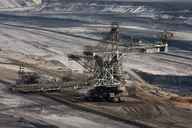Реклама 8
IN A high-tech world, dirty black lumps of coal might seem like an anachronism. Yet coal is far from a thing of the past. However whizzy your iPad, your wall-mounted television or your electric car, the chances are that it is powered by the stuff. Coal-fired power stations provide two-fifths of the world’s electricity, and there are ever more of them. In the doubling of the world’s electricity production over the past decade, two-thirds of the increase came from coal. At these rates, coal will vie with oil as the world’s largest source of primary energy within five years. As recently as 2001, it was not much more than half as important as oil.
The main factor has been the unslakable thirst for energy in China, which in 2011 overtook America as the world’s biggest electricity producer. In 2001, according to the International Energy Agency, a club of rich nations, Chinese coal demand was about 600m tonnes of oil equivalent (25 exajoules). By 2011 China’s coal demand had tripled—a rise from two-thirds of the energy America gets from oil to twice that amount. China’s domestic coal industry produces more primary energy than Middle Eastern oil does.
Other developing economies are just as keen on coal, if not yet on such a grand scale. In India, producing 650 terawatt hours of electricity in 2010 took 311m tonnes of oil equivalent, and the power sector’s coal demand is growing at around 6% a year. The IEA reckons India could surpass America as the world’s second-largest coal consumer by 2017.
But if America no longer dominates the business as it once did, what is happening to the industry there is still able to trigger changes far away. And at the moment coal is falling from favour in America.
King no more
In developing economies coal’s advantages—being cheap and widely available—are deemed to outweigh the damage it inflicts both on people near the places where it is burned (burning it gives off particles that harm people’s health) and on the planet as a whole (burning coal produces carbon dioxide, the most important long-lived greenhouse gas). In rich countries you might expect the cost-benefit balance to tip the other way, and coal use to be dropping. But things are not quite that simple. In America coal is indeed being burned less and less—but not principally thanks to climate policy, of which America has relatively little. Meanwhile in Europe, which likes to see itself as a world leader on climate, they are using more and more of the stuff (see article).
America’s coal business, like the rest of the country’s energy industry, has been upended by the advent of shale gas, now available in unforeseen quantities at unforeseen prices. In April 2012 the price fell below $2 per million British thermal units, or Btus ($7 per megawatt hour). This has made gas increasingly attractive to power companies, which have been switching away from coal in increasing numbers.
At its peak, in 1988, coal provided 60% of America’s electricity. Even in 2010, when the shale-gas boom was well under way, it still accounted for 42%. By the middle of 2012, though, gas and coal were roughly neck-and-neck, each with around a third of power generation.
There are two reasons for thinking the shift from coal may be long-lasting. One is that new gas is continuing to come on stream, and getting cheaper to produce. Though prices have started to rise from their earlier rock-bottom levels (they are now $3.43 per mBtu), it is unlikely to cost more than coal for a good while. And it will be fairly easy to use more gas without having to build new power stations. Around half of America’s gas-fired capacity is made up of so-called combined-cycle gas turbines (CCGT) which generate power come what may (the rest is used in “peakers” which generate only when needed). Utilisation rates in CCGTs have risen, but are still only 50%; they can use more.
The other reason why coal’s decline as a fuel may continue is that gas plants meet environmental regulations more easily. In the second Obama administration these are likely to stay in place or be extended. The coal industry’s lobbying power looks weaker following the election. Mitt Romney, who regularly attacked the president’s “war on coal”, had its full support, but that support did not deliver him the swing states of Virginia and Ohio.
As things stand, power plants will have to comply with rules governing emissions of mercury and other toxic nasties by 2015. Court challenges to further rules to control emissions of sulphur dioxide and oxides of nitrogen may delay these new standards, but will not kill them. And environmental rules promulgated under the Clean Air Act do not require congressional approval. Should Mr Obama decide to make environmental policy by fiat, the coal industry will feel the pinch.
The Environmental Protection Agency has already proposed restrictions on carbon emissions which would in practice ban new coal-fired plants after 2013 unless fitted with carbon capture and storage (CCS)—a technology has not yet been made to work on a commercial basis, though facilities planned for California and Texas may change that. Even without CCS, modern coal-fired power plants, though more efficient than the old ones and capable of being made a lot cleaner, are more expensive than those using old technology. They are twice the price of gas-fired plants with the same capacity. A gas facility can also be built in two to four years, instead of four to eight, giving utilities more flexibility when adding capacity.
This bodes ill for America’s coal plants. The combination of cheap gas and expensive regulation means that 50 gigawatts of coal-fired power capacity—a sixth of the total—could be shut down by 2017, according to Navigant, a consultancy. Others put the figure higher.
This means trouble for America’s coal miners. Coal production is likely to have fallen by roughly 100m tonnes in 2012, compared with 2011, or around 10% of the total. A surge in exports softened the blow: they rose by a quarter in the first half of 2012, to around 66m tonnes. The industry’s infrastructure is not geared to export—it is hard to get coal from Wyoming on to ships bound for China—but if that were rectified, analysts reckon, exports could reach 200m tonnes a year. In the meantime mining companies have been closing pits, shedding jobs and consolidating, especially in the least efficient mining areas of central Appalachia (West Virginia and Kentucky).
The decline of coal, though, will be protracted. Coal-fired power stations are built to last—the oldest plant currently operating was built in the 1930s—so unless new rules force them to close, they will be retired gradually. By 2017 or so, reckons Brattle Group, a consultancy, coal use will stabilise again, as gas demand finally makes gas prices dearer than coal. Coal may be down in America. But it is not yet out.






